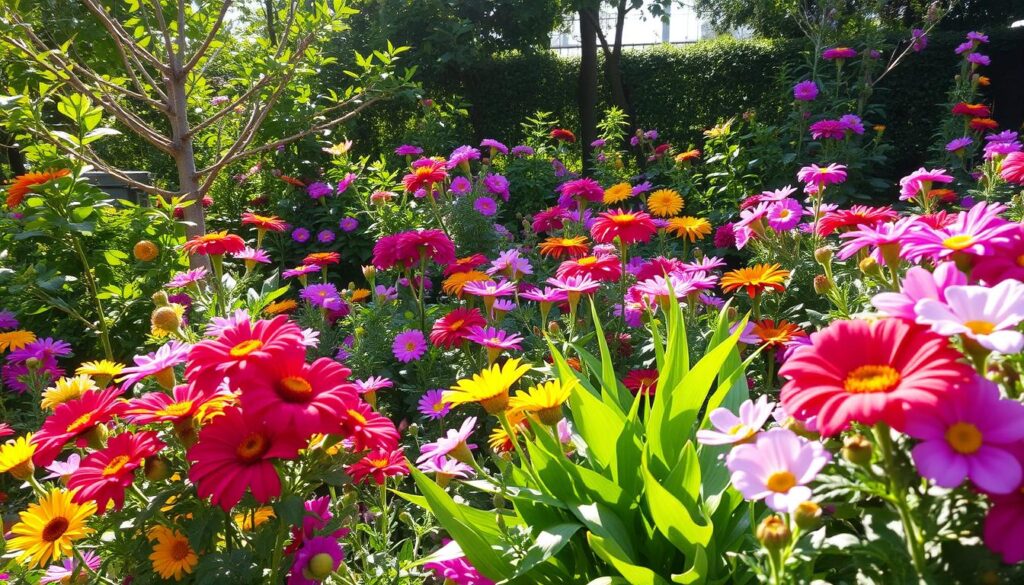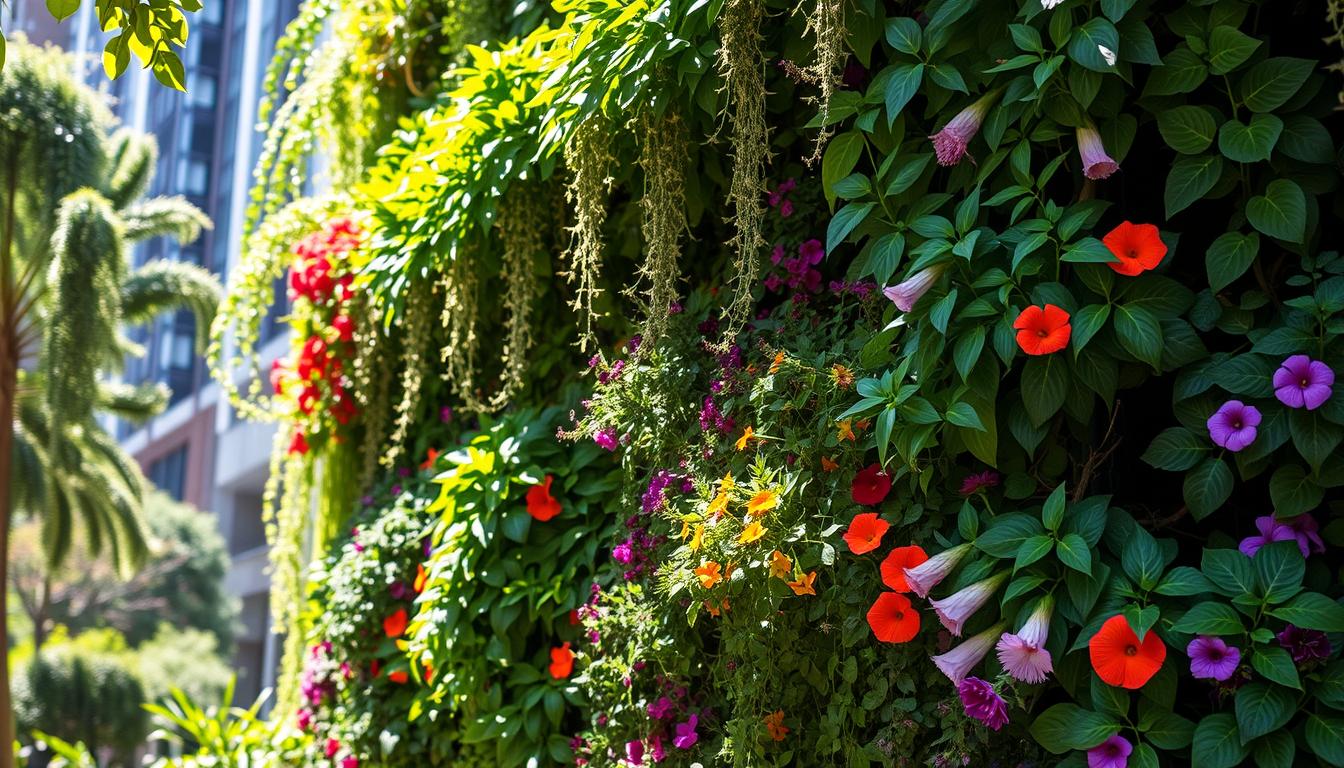Did you know that over 85% of people who visit gardens and parks feel better and less stressed? This shows how much our outdoor spaces affect our mood. The colors in gardens play a big role in how we feel. By picking the right colors, gardeners can make their spaces calm or lively, matching our moods.
In this article, we’ll dive into how colors and emotions connect in gardening. We’ll look at how choosing the right plants and design can boost our mood. This is all about using color psychology to create the perfect outdoor experience.

Key Takeaways
- The psychology of garden colors significantly affects emotional responses.
- Different colors can evoke various feelings, such as calmness or energy.
- Strategic selection of plants can enhance mood and atmosphere.
- Color theory plays an essential role in effective garden design.
- Understanding plant color psychology leads to tailored outdoor experiences.
Understanding the Psychology of Colors in Gardening
Exploring the psychology of colors shows how colors impact feelings in gardens. Different colors can change a garden’s mood, making color choice key in design. Knowing these effects lets gardeners craft spaces that stir specific emotions, improving the experience.
How Colors Affect Emotions in Gardens
Colors deeply influence our feelings. Cool colors like blue and green bring peace and calm. On the other hand, warm colors like red and yellow spark energy and excitement. Here’s a table that shows common colors and their emotional effects:
| Color | Emotional Impact |
|---|---|
| Blue | Calm, tranquility |
| Green | Balance, restoration |
| Yellow | Happiness, energy |
| Red | Excitement, passion |
| Purple | Creativity, luxury |
| White | Purity, simplicity |
The Role of Color Theory in Garden Design
Gardening with color psychology is about more than just colors. It’s also about how they work together. Color theory guides gardeners in mixing colors to get the right mood. By using this, gardeners can pick plants that look good together and match the garden’s mood.
For example, mixing bright flowers with soft leaves can make a garden pop with joy and creativity.
The Psychology of Garden Colors: How to Create a Mood with Plants
Creating a garden that feels emotionally impactful begins with picking the right plants. Each plant has its own colors and traits, affecting our mood in different ways. By knowing how plant colors impact us, we can make our gardens reflect our desired mood.
Choosing Plants for Emotional Impact
When picking plants, think about the emotions certain colors bring. For example:
- Lavender brings calm and relaxation.
- Sunflowers fill us with joy and positivity.
- Greenery like ferns makes us feel calm and connected to nature.
- Violet-painted blooms spark creativity and thoughtfulness.
Choosing plants wisely helps create a garden that matches our feelings and surroundings.
Incorporating Color Schemes for Mood Enhancement
To boost the mood of your garden, use color schemes that work together. Here are a few tips:
- Use a single color to create a peaceful vibe.
- Pair cool colors like blues and greens for a refreshing feel.
- Use contrasting warm colors to add energy and excitement.
By planning the layout and types of plants, you can create a welcoming space. It looks good and makes us feel better emotionally.

Plant Color Psychology: Emotional Effects of Garden Colors
Understanding the emotional effects of garden colors can turn outdoor spaces into peaceful havens or lively retreats. Plant color psychology is key in how we feel in our gardens. It affects our mood and feelings all year round. By choosing the right colors, gardeners can create spaces that feel just right.
Colors That Evoke Serenity and Calm
Cool tones like blue and green are known for their calming effects. They help us relax, perfect for quiet spots where we want to unwind. Adding plants like lavender, sage, or fountain grass can make the calm even deeper. Using these colors in garden designs can help reduce stress and boost our mental health.
Vibrant Hues for Energy and Joy
On the other hand, bright colors like red, orange, and yellow bring energy and joy. They make us feel good, making them great for areas where we want to have fun. Adding happy flowers like sunflowers or gerbera daisies can make the space lively and full of excitement.
The Influence of Seasonal Colors on Mood
Seasons change the colors in a garden, affecting our mood. Spring brings bright pastels and bold blooms, showing new beginnings. Summer is full of vibrant colors, reflecting warmth and joy. Autumn offers rich, earthy tones, bringing comfort and nostalgia. Winter highlights whites and grays, inviting quiet reflection. Knowing these seasonal colors helps gardeners plan for the best mood all year.
Creating a Garden Atmosphere through Color
Designing a magical garden starts with color psychology. By picking the right colors for each area, you make spaces that meet different needs and moods. Colors shape how we see and use these areas, from calm spots to fun play zones.
Designing Functional Spaces with Color Psychology
Knowing how color affects us helps gardeners plan better. Colors can stir up different feelings, guiding how we feel in the garden. For example, cool blues and greens calm us down in quiet spots. But, bright reds and yellows get us moving and excited in play areas.
Here’s a table showing how colors are used in gardens:
| Color | Emotion | Garden Area Example |
|---|---|---|
| Blue | Calmness | Zen gardens, meditation spaces |
| Green | Rejuvenation | Herb and vegetable patches |
| Yellow | Happiness | Children’s gardens, play areas |
| Red | Energy | Entertaining spaces |
| Purple | Creativity | Artistic corners, floral displays |
Using Plants for Mood Creation and Enhancement
Choosing plants wisely adds to the garden’s mood. It’s about picking plants that affect our feelings. Lavender calms us, while sunflowers make us happy. These plants make our senses come alive and match the garden’s mood.
By combining these ideas, we create a place where everyone finds joy. It shows how garden design can make a space beautiful and emotionally rich.

Conclusion
The psychology of garden colors shows how different hues can change our emotions. This knowledge helps gardeners make spaces that bring peace, joy, and energy. By choosing plants wisely and arranging them with color theory, gardens can be more than beautiful. They can be places of emotional healing.
Using certain colors in gardens can deepen our bond with nature. For example, blues and greens can make a calm retreat. On the other hand, yellows and reds can boost our mood and energy. This makes gardening a key way to improve mental health through nature.
By applying color psychology in gardening, we can create spaces that help us grow emotionally. A well-designed garden can be a source of happiness, reflection, and connection with nature. It turns simple outdoor areas into powerful tools for our well-being and emotional strength.
FAQ
What is the psychology of garden colors?
The psychology of garden colors looks at how colors affect our feelings in outdoor spaces. It helps gardeners make spaces that boost our mood and well-being. This is done by choosing plants wisely.
How can I use plant colors to enhance my mood?
Plant colors greatly affect our mood. Calming blues and greens make spaces peaceful. On the other hand, bright yellows and oranges bring energy and happiness. By picking these colors, you can make a garden that matches your mood.
Which plants are best for creating a serene garden atmosphere?
For a calm garden, use plants like lavender, chamomile, or pale blue hydrangeas. They make your garden look beautiful and feel peaceful.
What role does color theory play in garden design?
Color theory is key in garden design. It helps mix colors in a way that creates the right mood. Knowing how colors work together can turn a simple garden into a lively, emotional space.
How can seasonal colors affect my garden mood?
Seasonal colors change your garden’s mood. Plants show different colors at different times. By planning your garden with these changes in mind, you can make a garden that always looks new and exciting.
Can the emotional impact of garden colors improve mental well-being?
Yes, garden colors can make us feel better. By picking plants and colors that make us happy, you can create a space that relaxes and uplifts us. It helps us feel closer to nature.
What are some examples of mood-enhancing plants?
Plants like sunflowers make us happy, lavender calms us, and marigolds energize us. Choosing plants that match our mood can make our garden feel just right.
How does garden design psychology influence outdoor spaces?
Garden design psychology makes outdoor spaces more emotional and meaningful. By using colors and design wisely, gardeners can create areas for relaxation, work, or fun.
What is plant color symbolism in gardening?
Plant color symbolism is about the meanings of colors in gardening. For example, blue means calm, and red means passion. Knowing these meanings helps gardeners pick plants that match their goals.
How can I create a cohesive color scheme in my garden?
To have a unified color scheme, choose plants that complement each other. Use a color wheel to find colors that work well together. This creates a garden that looks and feels good.




